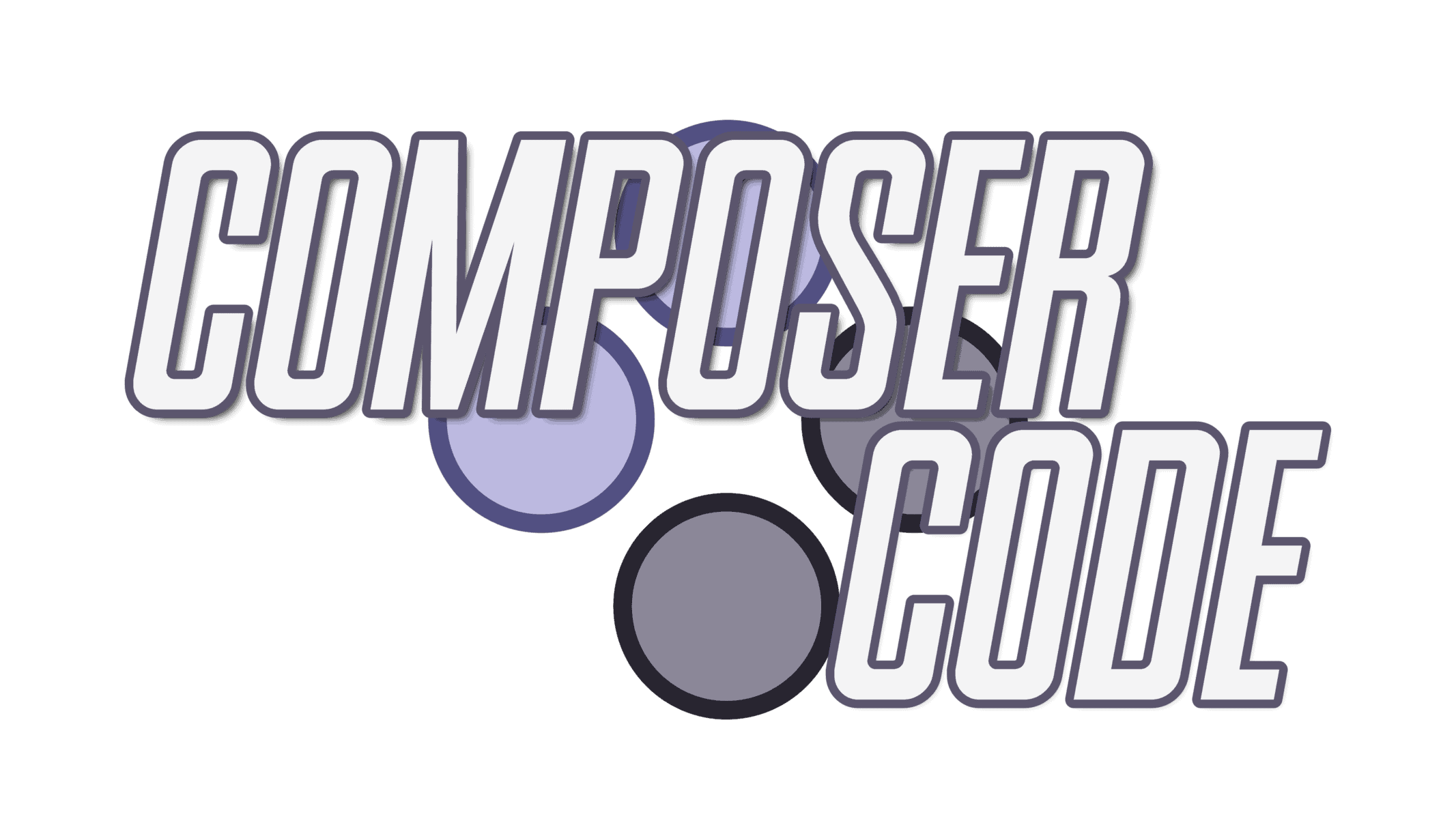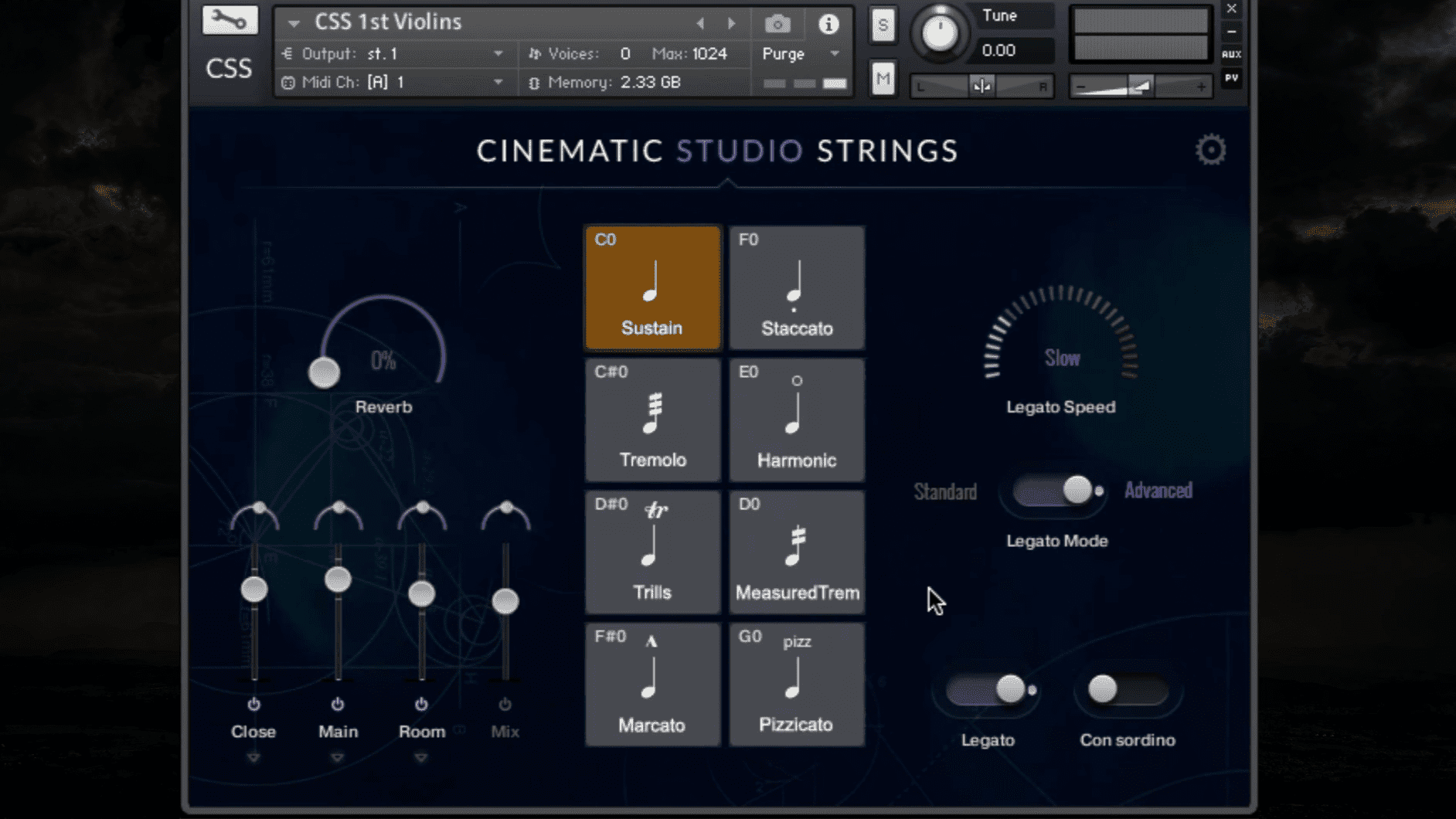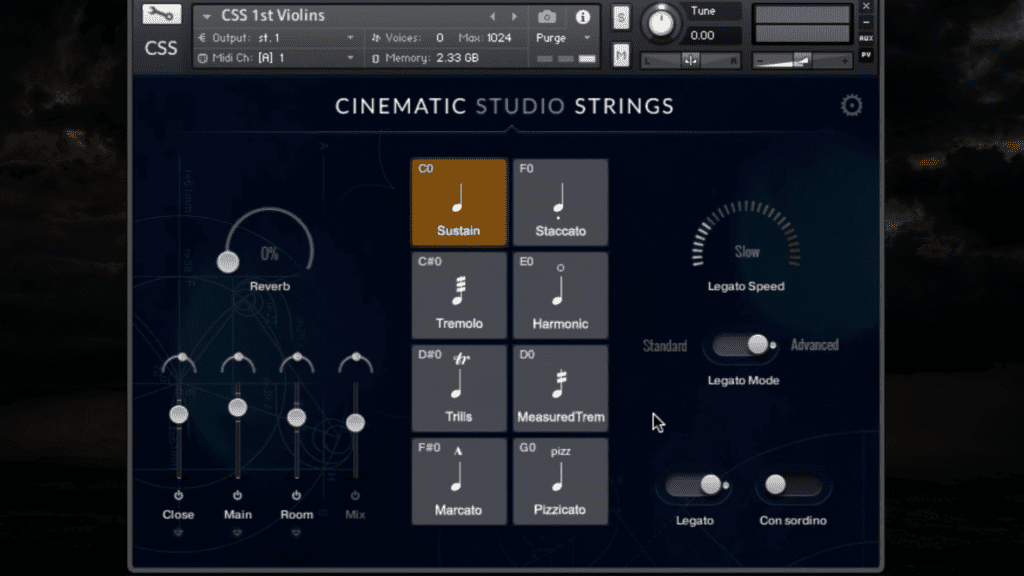
In the world of music production, Kontakt libraries are industry-standard tools for composers and producers looking to create breathtaking soundscapes and memorable scores.
These libraries, powered by Native Instruments’ Kontakt sampler, offer a wide range of sounds, from orchestral instruments to unique sound design elements, providing an endless palette for your creative endeavors.
If you’re a game, film, or media composer, it’s only a matter of time before you encounter a client that utters those old familiar words:
“I’m looking for that really cinematic sound.”
Cinematic music and sounds play a crucial role in music production and film scoring, helping to create an atmosphere, evoke emotions, and bring visuals to life. Without the right sonic textures, even the most beautifully shot scenes or gameplay scenarios can fall flat.
When it comes to selecting the best cinematic Kontakt libraries, several factors come into play. These include the quality of the sounds, the diversity of the instruments, ease of use, and how well the library integrates with your digital audio workstation (DAW).
In this article, I’ll take a look at some of the best picks for cinematic Kontakt libraries, offering insights into their features, strengths, and weaknesses, to help you make an informed decision.
Let’s dive in!
Top 10 Cinematic Kontakt Sample Libraries
Spitfire Audio – Albion One: A Versatile Cinematic Powerhouse ($449)

Overview and features
Spitfire Audio’s Albion One is a highly acclaimed cinematic Kontakt library that has been praised for its versatility and rich sound palette.
I praised Albion One in my article on the best Kontakt libraries overall, and I’ll praise it again here. It strikes that perfect balance of being an approachable, all-in-one cinematic sample library that won’t break the bank.
It features a 109-piece orchestra, an extensive range of percussion, and a cutting-edge synth section, making it suitable for various projects and genres.
Albion One comes with a user-friendly interface and offers an extensive selection of articulations, dynamic layers, and round robins for a truly realistic and expressive sound.
Pros and cons
Pros:
- High-quality sounds and recordings
- Wide range of instruments and articulations
- User-friendly interface
- Ideal for both traditional and modern cinematic scoring, including electronic music
Cons:
- Large library size, requiring significant storage space
- Can be resource-intensive on older systems
Suitable genres and projects
Albion One is perfect for composers and producers working on a wide range of projects, from epic film scores to delicate emotional pieces.
Its comprehensive selection of orchestral, percussive, and synthetic sounds make it an excellent choice for genres like action, adventure, drama, fantasy, and even sci-fi.
Whether you’re scoring a blockbuster movie, an indie film, or a video game, Albion One has the tools to help you create a stunning cinematic soundscape.
Heavyocity – Gravity: Pushing the Boundaries of Cinematic Sound Design ($449)
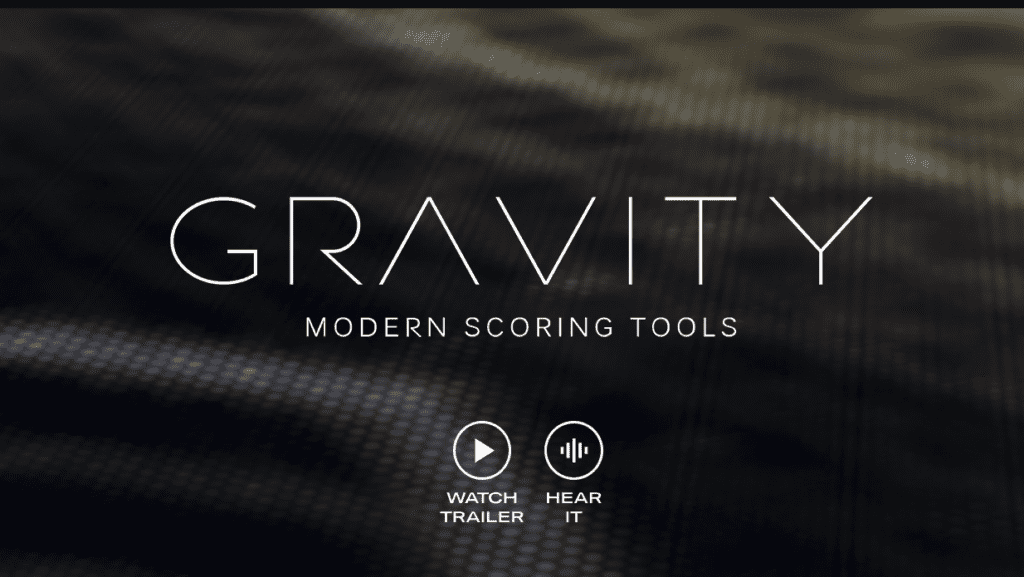
Overview and features
Gravity by Heavyocity is a groundbreaking cinematic Kontakt library that focuses on modern sound design and hybrid scoring.
It offers a massive collection of pads, risers, stingers, impacts, and other sound design elements, as well as an innovative “Motion” engine that allows you to create evolving textures and atmospheres easily.
With over 2,200 sound sources and 1,200 presets, Gravity provides endless possibilities for creating unique and immersive soundscapes.
Pros and cons
Pros:
- Extensive sound design capabilities
- High-quality sounds and recordings
- “Motion” engine for creating evolving textures
- Comprehensive selection of presets
Cons:
- Lacks traditional orchestral elements (and therefore must be supplemented with another library for that traditional orchestral sound)
- May have a steeper learning curve for some users
Suitable genres and projects
Gravity is ideal for composers and producers who want to push the boundaries of traditional cinematic scoring and delve into hybrid sound design.
Its extensive collection of sounds and textures makes it suitable for genres like sci-fi, thriller, horror, and experimental.
Whether you’re working on a feature film, a video game, or a multimedia project, Gravity’s cutting-edge sound design tools will help you create a truly unique sonic experience.
8Dio – Majestica: The Ultimate Orchestral Powerhouse ($400)

Overview and features
Majestica by 8Dio is a colossal cinematic Kontakt library, boasting a massive 240-piece orchestra, making it one of the largest symphonic libraries available.
This library features a wide array of orchestral instruments, including strings, brass, woodwinds, and percussion, along with an extensive selection of articulations and legato patches.
Majestica is designed for composers who want to create large, epic, and powerful scores, providing an unmatched depth and richness of sound.
Pros and cons
Pros:
- Huge 240-piece orchestra for a powerful sound
- Wide range of instruments and articulations
- High-quality recordings and performances
- Great for epic and grandiose scoring
Cons:
- Requires a significant amount of storage space
- Can be resource-intensive on some systems
- May not be suitable for smaller, more intimate projects
Suitable genres and projects
Majestica is perfect for composers and producers who want to create epic, powerful, and grandiose scores. Its massive orchestral sound makes it suitable for projects in genres such as action, adventure, fantasy, and historical drama.
Whether you’re scoring a big-budget film, a high-stakes video game, or an epic trailer, Majestica will provide you with the enormous sound you need to make a lasting impact on your audience.
Native Instruments – Thrill: Mastering Tension and Atmosphere ($299)

Overview and features
Thrill by Native Instruments is a unique cinematic Kontakt library specifically designed for creating tension, suspense, and atmospheric soundscapes.
With over 1,000 orchestral and hybrid sound sources, Thrill’s innovative X-Y control allows users to blend and morph between sounds effortlessly, making it easy to create evolving textures and eerie ambiances.
In addition, the library includes a wide range of pre-designed clusters, stings, and hits, perfect for adding instant tension to any scene.
Pros and cons
Pros:
- Designed for creating tension and suspense
- Innovative X-Y control for blending and morphing sounds
- Extensive collection of pre-designed elements
- High-quality sounds and recordings
Cons:
- More focused on tension and atmosphere, less versatile for other scoring styles
- May require some experimentation to fully utilize its potential
Suitable genres and projects
Thrill is ideal for composers and producers working on projects that require a strong sense of tension, suspense, and atmosphere.
Its unique sound design capabilities make it suitable for genres such as thriller, horror, mystery, and crime dramas.
Whether you’re scoring a nail-biting scene in a film, designing sound for an immersive video game, or creating the perfect ambiance for a tense TV show, Thrill will help you master the art of suspense and atmosphere.
ProjectSAM – Symphobia Series: Unleashing Your Orchestral Imagination ($329 – $549)
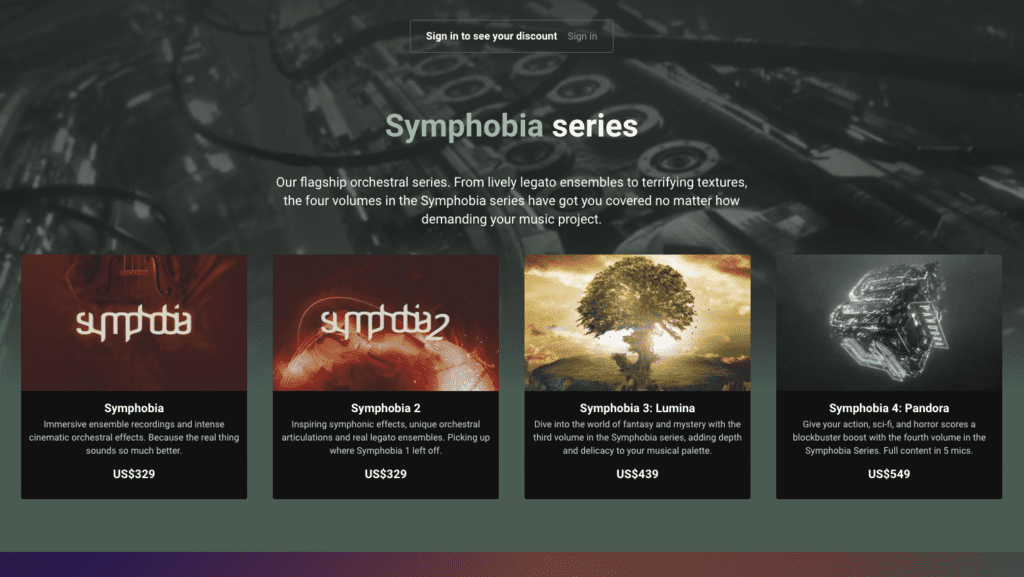
Overview and features
The Symphobia Series by ProjectSAM is a collection of cinematic Kontakt libraries that offer a unique approach to orchestral sampling.
Rather than focusing on individual instruments, Symphobia provides ensemble recordings, capturing the true essence of an orchestra playing together.
Each of the four tentpole libraries offers a different approach to orchestral scoring:
Symphobia ($329)
The first library in the series, Symphobia, is focused on providing ensemble multi-samples and effects. It covers a wide range of orchestral instruments and sections, including strings, brass, and woodwinds.
The library features various articulations and playing styles, as well as unique orchestral effects, such as clusters, glissandi, and hits. Symphobia is designed to provide a comprehensive foundation for creating realistic orchestral mock-ups.
Symphobia 2 ($329)
The second library, Symphobia 2, builds on the foundation set by Symphobia and expands it with more content and features.
It introduces new articulations, unique ensembles, and additional effects. It also includes a legato ensembles feature, allowing for smoother and more realistic note transitions.
Symphobia 2’s focus is on providing composers with more flexibility and expressiveness, making it easier to create diverse and detailed orchestral arrangements.
Symphobia 3: Lumina ($439)
Lumina is the third library in the series and takes a slightly different approach. It is tailored towards scoring for film, TV, and video games, with a focus on storytelling and fantasy-themed content.
Lumina includes a diverse selection of orchestral instruments, choir, and hybrid sound design elements. It also introduces a unique “three-layer concept” that allows users to blend different sounds and textures together easily.
This library is perfect for composers looking to create rich and evocative scores with a touch of cinematic magic.
Symphobia 4: Pandora ($549)
Pandora is the fourth installment in the series and focuses on providing users with a powerful and versatile tool for creating action, sci-fi, and horror scores.
The library includes a vast collection of orchestral effects, phrases, and playable instruments.
Pandora’s standout feature is its “Adaptive Sync” technology, which automatically adjusts the timing of samples and phrases to fit the user’s tempo, making it incredibly easy to create complex and precisely timed arrangements.
Additionally, Pandora offers more advanced sound design possibilities, giving users more control over their compositions.
Pandora features endless amounts of powerful risers, rollers, crescendos, and haunting textures, making it a one-stop shop for horror, sci-fi, or action genres.
In summary, each library in the Symphobia series caters to different needs and preferences, with unique features, instruments, and content.
Symphobia and Symphobia 2 provide a solid foundation for orchestral mock-ups, while Lumina and Pandora excel in creating cinematic and edgy scores, respectively.
Pros and cons
Pros:
- Ensemble recordings for a more cohesive sound
- Multiple libraries with various focuses and themes
- High-quality sounds and performances
- Excellent for adding depth and character to scores
Cons:
- Less control over individual instruments compared to other libraries
- Can be expensive to collect the entire series
Suitable genres and projects
The Complete Symphobia Series pretty much covers every genre imaginable. It’s perfect for composers and producers working on a wide range of projects, from emotional dramas to epic action scenes.
Its unique approach to ensemble recording makes it suitable for various genres, including action, adventure, drama, fantasy, and even horror.
Whether you’re scoring a feature film, a TV show, or a video game, the Symphobia Series offers a distinctive orchestral sound that will bring your project to life.
Audio Imperia – Nucleus: The All-in-One Cinematic Solution ($449)

Overview and features
Nucleus by Audio Imperia is a comprehensive cinematic Kontakt library that offers a well-rounded selection of orchestral instruments, choir, and sound design elements.
Designed with versatility and ease of use in mind, Nucleus features a streamlined interface, making it simple to access a wide range of articulations and performance techniques.
This library is perfect for composers looking for a high-quality, all-in-one solution for cinematic scoring.
Pros and cons
Pros:
- Comprehensive selection of orchestral instruments, choir, and sound design elements
- Streamlined interface for ease of use
- High-quality sounds and recordings
- Versatile library suitable for various projects and genres
Cons:
- Lacks some of the more specialized sounds found in dedicated libraries
- May not be as extensive as some larger, more expensive libraries
Suitable genres and projects
Nucleus is ideal for composers and producers working on a diverse range of projects, from subtle emotional scenes to epic action sequences.
Its well-rounded selection of sounds makes it suitable for various genres, including action, adventure, drama, fantasy, and even horror.
Whether you’re scoring a film, a TV show, or a video game, Nucleus provides a solid foundation for creating compelling and memorable scores.
Orchestral Tools – Metropolis Ark 1: Crafting Epic and Powerful Scores ($599)
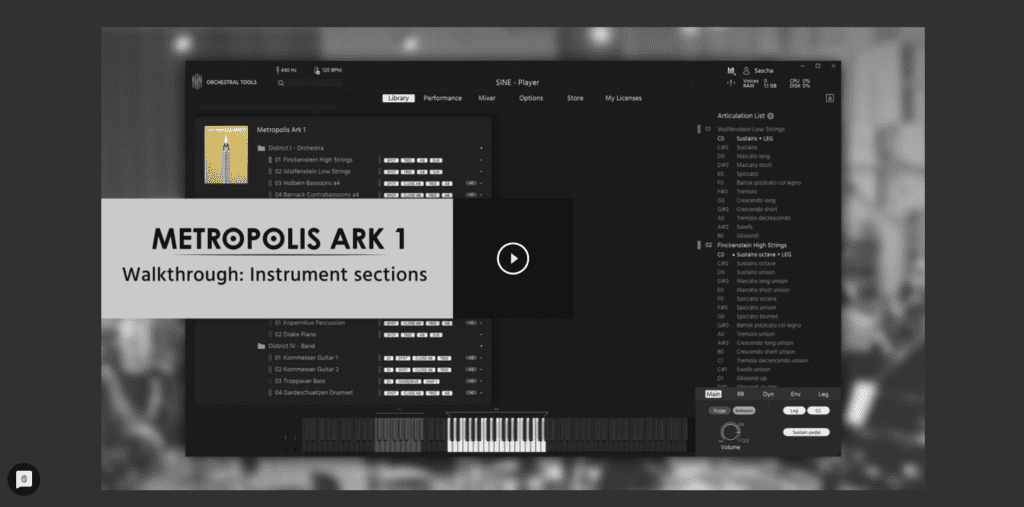
Overview and features
Metropolis Ark 1 by Orchestral Tools is a cinematic Kontakt library designed for creating epic and powerful scores.
Featuring a vast selection of orchestral instruments, choirs, and percussion, this library was recorded at the legendary Teldex Scoring Stage in Berlin, ensuring the highest quality sound.
Metropolis Ark 1 focuses on providing a larger-than-life sound, with massive ensembles and unique instrument combinations, perfect for composers looking to create bold and unforgettable scores.
Pros and cons
Pros:
- Massive ensembles for a powerful and epic sound
- High-quality recordings at the Teldex Scoring Stage
- Unique instrument combinations for added character
- Excellent for creating bold and unforgettable scores
Cons:
- May not be suitable for smaller, more intimate projects
- Requires a significant amount of storage space
Suitable genres and projects
Metropolis Ark 1 is perfect for composers and producers working on projects that demand an epic and powerful sound.
Its focus on larger-than-life ensembles makes it suitable for genres such as action, adventure, fantasy, and historical epics.
Whether you’re scoring a blockbuster film, an epic video game, or a high-stakes TV show, Metropolis Ark 1 will provide the tools you need to create a powerful and memorable score.
Cinematic Studio Strings: A Lush and Expressive Strings Library ($399)

Overview and features
Cinematic Studio Strings is part of the Cinematic Studio Series, offering a meticulously sampled and highly expressive strings library for Kontakt.
This is not exactly a hot take, but strings are well-regarded as the heart and soul of the traditional orchestra.
Yet, capturing a true-to-life string sound is one of the most difficult things to do; they are some of the most nuanced and subtle instruments in existence, with dozens (perhaps hundreds) of ways to play them.
That’s not even taking into account things like playing dynamics, which completely change the timbre of the sound.
Featuring a comprehensive selection of stringed instruments, articulations, and performance techniques, this library was recorded in a world-class scoring stage to ensure top-notch sound quality.
With a beautifully intuitive interface and realistic legato scripting, Cinematic Studio Strings allows composers to create lush and emotive string arrangements with ease.
Pros and cons
Pros:
- Comprehensive selection of string instruments and articulations
- High-quality recordings in a world-class scoring stage
- Intuitive interface and realistic legato scripting
- Ideal for creating lush and emotive string arrangements
Cons:
- Focuses exclusively on strings, requiring additional libraries for other orchestral elements
- May be resource-intensive on some systems
Suitable genres and projects
Cinematic Studio Strings is perfect for composers and producers working on projects that require emotional and expressive string arrangements.
Its comprehensive selection of string instruments and articulations make it suitable for various genres, including drama, romance, fantasy, and even action.
Whether you’re scoring a heartfelt film, a touching TV show, or an evocative video game, Cinematic Studio Strings will help you craft the perfect string ensemble to enhance your project’s emotional depth.
Soundiron – Apocalypse Percussion Ensemble: Epic Percussion for Cinematic Scoring ($199)
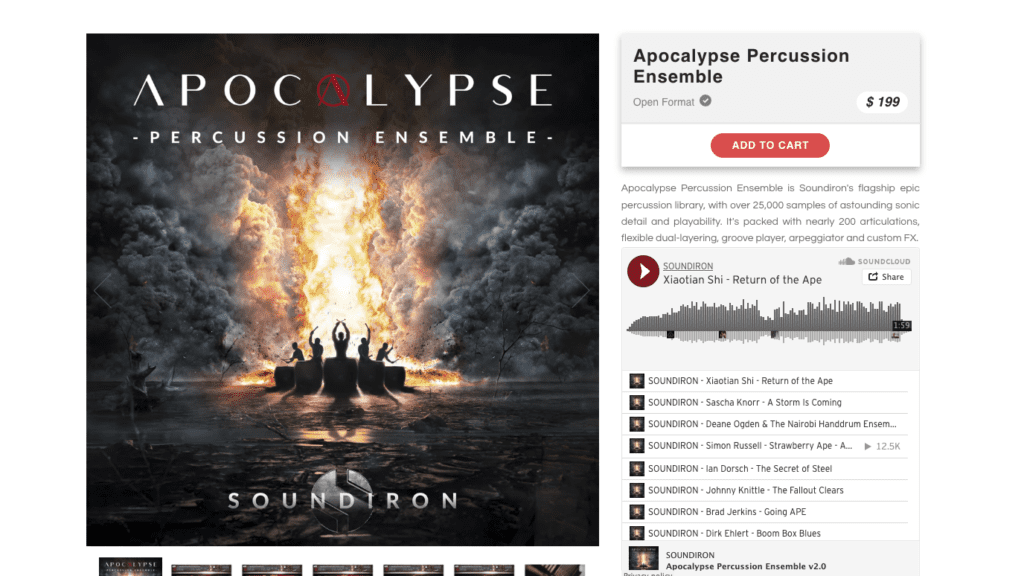
Overview and features
Apocalypse Percussion Ensemble by Soundiron is a comprehensive and powerful cinematic percussion library for Kontakt. Featuring a wide range of drums, cymbals, and auxiliary percussion instruments, this library was meticulously sampled to capture the raw energy and impact of each performance.
With a user-friendly interface, flexible mic positions, and a deep collection of ensemble and solo patches, Apocalypse Percussion Ensemble is perfect for composers looking to add thunderous percussion to their scores.
Pros and cons
Pros:
- Wide range of percussion instruments and articulations
- High-quality recordings and performances
- User-friendly interface and flexible microphone positions
- Excellent for adding impact and energy to scores
Cons:
- Focuses exclusively on percussion, requiring additional libraries for other orchestral elements
- Some users may find the library to be resource-intensive
Suitable genres and projects
Apocalypse Percussion Ensemble is ideal for composers and producers working on projects that require powerful and epic percussion elements.
Its extensive collection of percussion instruments makes it suitable for genres such as action, adventure, fantasy, and historical epics.
Whether you’re scoring a pulse-pounding film, an intense video game, or a dramatic trailer, Apocalypse Percussion Ensemble will provide the thunderous percussion needed to drive your project’s energy and impact.
Sonuscore – The Orchestra Complete: Orchestral Scoring Made Simple ($479)
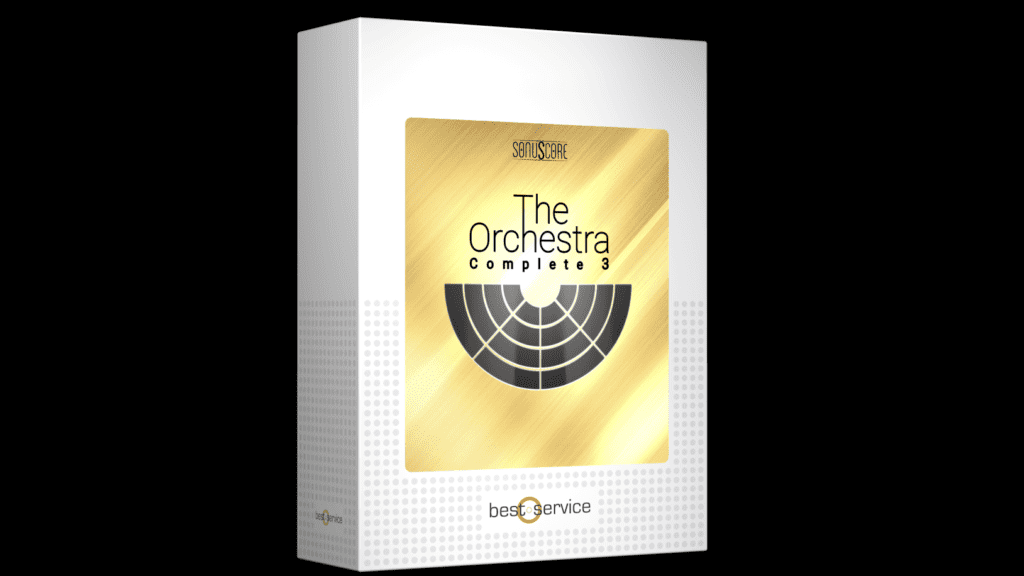
Overview and features
The Orchestra Complete by Sonuscore is a revolutionary cinematic Kontakt library designed to simplify the process of creating realistic orchestral scores.
Combining a comprehensive selection of orchestral instruments with a groundbreaking “Orchestra-in-a-Box” approach, this library allows composers to quickly build intricate arrangements without sacrificing quality or realism.
With its intuitive interface, unique arpeggiator engine, and powerful scripting, The Orchestra Complete is perfect for composers looking for a streamlined and inspiring way to create orchestral music.
Pros and cons
Pros:
- Comprehensive selection of orchestral instruments
- Groundbreaking “Orchestra-in-a-Box” approach
- Intuitive interface and unique arpeggiator engine
- Excellent for rapid orchestral scoring
Cons:
- May not offer the same level of control as more specialized libraries
- Requires a learning curve to fully utilize the unique features
Suitable genres and projects
The Orchestra Complete is perfect for composers and producers working on a wide range of projects that require orchestral scoring and the delicate sound of those individual acoustic instruments.
Its streamlined approach makes it suitable for various genres, including action, adventure, drama, fantasy, and even romance.
Whether you’re scoring a feature film, a TV show, or a video game, The Orchestra Complete offers a fast and efficient way to create high-quality orchestral music that will enhance your project’s emotional impact.
Honorable Mentions: More Cinematic Kontakt Libraries Worth Exploring
There are numerous other cinematic Kontakt libraries that deserve a mention, each with its own unique features and highlights. Here are a few more libraries worth considering:
- Spitfire Audio – Hans Zimmer Strings: A collaboration between Spitfire Audio and legendary composer Hans Zimmer, this library offers a new approach to string sampling and innovative articulations.
- Cinesamples – CineBrass Pro: An expansion to the popular CineBrass library, featuring a wide range of brass instruments and articulations, perfect for epic and dramatic scoring.
- Performance Samples – Oceania: A powerful and expressive choir library with vocal samples that utilize a unique phrase-building approach, great for adding a touch of human voice to your scores.
- Vir2 Instruments – Aeris Hybrid Choir Designer: A library that combines traditional choir recordings with modern sound design elements, allowing for unique and atmospheric choral textures.
Tips for Choosing the Right Cinematic Kontakt Library
Assessing your needs and project requirements
Before purchasing a cinematic Kontakt library, consider the specific needs of your project. What kind of instruments, articulations, and textures are required?
Choose a library that aligns with your project’s goals and provides the sounds you need.
I’m a big fan of “just-in-time” purchasing as opposed to “just-in-case” purchasing.
Meaning, don’t just go drop a ton of money on libraries because you think you “might” get a gig scoring that genre. Instead, wait until you have a specific project that requires a particular sound and let that inform your purchases.
Budget considerations
Cinematic Kontakt libraries can vary greatly in price, so consider your budget before making a purchase.
While more expensive libraries often offer more extensive features and higher-quality sounds, some of the best Kontakt libraries are totally free or inexpensive.
Ease of use and learning curve
Some cinematic Kontakt libraries have a steeper learning curve than others.
Consider your level of experience and how much time you’re willing to invest in learning the ins and outs of a new library.
Look for libraries with intuitive interfaces and user-friendly documentation to help you get started quickly.
Final Thoughts: Unleashing your Cinematic Creativity
Recap of the top cinematic Kontakt libraries
In this article, we’ve explored some of the best cinematic Kontakt libraries available.
Each of these libraries offers unique features, sounds, and capabilities, making them excellent choices for composers and producers looking to create compelling and memorable cinematic scores.
FAQs about cinematic Kontakt libraries and instruments
What is a virtual instrument?
A virtual instrument is a software-based representation of a physical instrument or sound source that can be played and manipulated using a computer or digital audio workstation (DAW).
Virtual instruments are designed to recreate the sound and behavior of real instruments, such as pianos, guitars, drums, or orchestral instruments, as well as synthesized sounds and sound effects.
They can be played using MIDI controllers, such as keyboards or drum pads, and can be used in music production, sound design, and live performance settings.
What are some of the best Kontakt libraries for sound designers?
For sound designers working on cinematic projects, there are numerous Kontakt libraries that provide a wide range of sounds, textures, and effects. Some of the best Kontakt libraries for sound designers include:
- Spitfire Audio – Albion One
- Heavyocity – Gravity
- 8Dio – Hybrid Tools Series
- Native Instruments – Rise & Hit
- Soundiron – Apocalypse Percussion Ensemble
- Audio Imperia – Trailer Guitars
- Gothic Instruments – DRONAR Series
- Output – REV
- Sonuscore – The Orchestra Complete
- UVI – World Suite
Each of these libraries offers unique features and sounds, catering to different aspects of sound design and providing a wealth of creative possibilities.
Which are the best Kontakt libraries for acoustic sounds?
Kontakt libraries for acoustic sounds aim to faithfully reproduce the nuances and expressiveness of real acoustic instruments.
Some of the best Kontakt libraries for acoustic sounds include:
- Native Instruments – Session Strings Pro
- Spitfire Audio – Hans Zimmer Piano
- Orange Tree Samples – Evolution Series
- 8Dio – New Epic Toms Ensemble
- Embertone – Friedlander Violin
- Impact Soundworks – Ventus Ethnic Winds Series
- Fluffy Audio – Trio Broz: Solo Violin
- Cinesamples – CineBrass Pro
- Cinematic Studio Series – Cinematic Studio Piano
- Chris Hein – Solo Cello
These libraries focus on capturing the authentic sound and performance characteristics of acoustic instruments, making them ideal for composers and producers seeking realistic and expressive acoustic sounds.
Need inspiration? Keep exploring different libraries and sampled instruments
The world of cinematic Kontakt libraries and Kontakt instruments is vast, with countless inspiring sounds to suit different needs, styles, and budgets.
Don’t be afraid to explore different libraries and expand your creative potential. Watch YouTube walkthroughs and live compositions and assess your particular needs.
By experimenting with various sounds and instruments, you can develop your own unique voice as a composer of cinematic music and create unforgettable scores that captivate and inspire your audience.
Thanks for reading, and happy composing!
